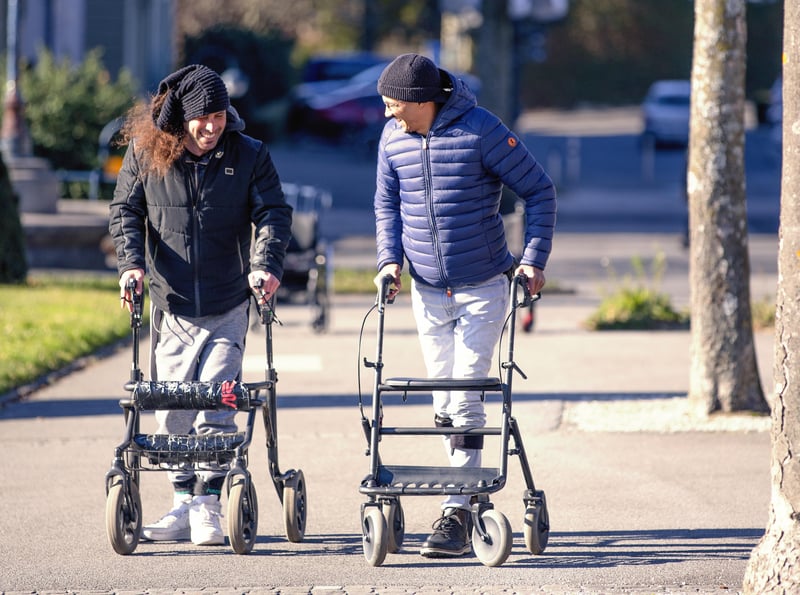Get Healthy!

- Posted February 7, 2022
New Technology Restores Movement After Spinal Cord Paralysis
A motorcycle crash left Michel Roccati with complete lower-body paralysis from a devastating spinal cord injury.
That was in 2017.
But now, the Italian native is walking again, courtesy of groundbreaking Swiss research that restores motor function within one day by means of carefully targeted electrical stimulation.
"At the beginning, I was unable to move the muscles of the legs, and I feel nothing," Roccati recalled recently.
Now he can stand, walk and do stairs. In fact, "everything I have in mind to train I can do with the stimulation," Roccati said at a press briefing hosted by Nature Medicine, which recently published the findings.
According to the World Health Organization, every year from 250,000 to a half-million people around the world suffer a seriously disabling spinal cord injury, most often the result of a fall, violence or, like Roccati, a traffic accident. Compared to people without this injury, they are two to five times more likely to die prematurely.
Roccati is one of three patients enrolled in the Swiss effort, all men between 29 and 41 years old. Each had experienced a complete spinal cord injury at least a year prior to the study's launch.
"This means that they could not move the legs, and they did not have any sensation over the legs," said study co-author Dr. Jocelyne Bloch, a neurosurgeon and chief of the functional neurosurgery unit at Lausanne University Hospital in Switzerland.
Speaking at the briefing, Bloch noted that in 2020 the three men underwent surgery at NeuroRestore in Lausanne to implant a pacemaker in the abdomen and electrodes directly onto the spinal cord.
Those electrodes are themselves an important innovation, explained study colleague and neuroscientist Grégoire Courtine.
Constructed to be permanent, they are "precisely positioned to target all the regions of the spinal cord that are relevant to activate trunk and leg muscles," said Courtine, who is with the Swiss Federal Institute of Technology in Lausanne.
The electrodes were then paired with new software that facilitated a highly personalized mapping of each patient's spinal cord, Courtine said in the briefing.
The software also provides a simple tablet-based interface that allows patients and physical therapists to easily set up semi-automated stimulation programs that enable a variety of movements.
Patients can operate these programs themselves, via a tablet and small remote controls that can communicate wirelessly to the patient's pacemaker.
For Roccati, all this meant that following a 10-day post-surgery recovery period, rehab began -- and "I was able to walk after one day," he said. The remote controls are attached to his walker.
"Thanks to this technology, all three patients, immediately after surgery, were able to stand up and walk," said Bloch during the briefing. Pedaling, swimming, and torso movement were also enabled. None reported any pain or side effects triggered by the stimulation.
Still, Bloch noted that motor control "was not perfect at the very beginning." And Courtine emphasized that regaining movement post-surgery is a process, "not a miracle." with patients initially needing a lot of physical support. Also, "the recovery of sensation is very different from one patient to the other," he added.
"But what it does, is enable an immediate ability to train," Courtine noted. And because the technology is small and portable, that training can take place out in the real world.
Every day, with the stimulation turned on, "Michel is able to stand for two hours, and he walks almost 1 kilometer (.6 of a mile) straight, without stopping," in addition to climbing up and down stairs, said Courtine. "When the stimulation is turned off, he had some recovery, but to a very limited extent."
Bloch said the technology would almost certainly work equally well among female paralysis patients.
And while future research may expand what's possible, Bloch acknowledged one key limitation: "We need at least 6 centimeters of healthy spinal cord under the lesion. That's where we implant our electrodes."
Claudia Angeli, director of the University of Louisville's Spinal Cord Injury Research Center in Kentucky, agreed the Swiss team's work is "encouraging," but said other approaches also show merit.
"This group is using a very specific stimulation" signaling method, while alternative efforts attempt to enable motor control via direct stimulation of brain signals, she said.
Such alternative approaches "have shown similar results," Angeli noted. "There has not been a direct comparison of the two methods, but both are showing promise for recovery following spinal cord injury."
Meanwhile, the Swiss team has a trial in the works in the United States. The researchers noted that the U.S. Food and Drug Administration has approved a "breakthrough devices" designation to expedite the process whereby the technology could become commercially available. This designation would also ensure coverage through the Medicare Coverage of Innovative Technology program if larger clinical trials are successful, the researchers said.
As for Roccati, after nine months of Lausanne-based rehab, he now lives independently in Italy. "I continued rehab at home, working alone, with all the devices," he said. "And I see improvements every day."
More information
There's more on spinal cord injuries and paralysis at Christopher & Dana Reeve Foundation.
SOURCES: Claudia Angeli, PhD, assistant professor, School of Engineering, University of Louisville, and director, Kentucky Spinal Cord Injury Research Center; press briefing, Feb. 2, 2022, and Nature Medicine, Feb. 2, 2022
